Salmon remains one of the most well-loved and frequently eaten fish in the U.S. According to Seafood Source, Americans grilled, fried, steamed, and poached a record-breaking amount of seafood in 2021. Amongst the top contenders, salmon took the silver medal as the most popular seafood item, just below shrimp (canned tuna finished in a surprising third place).
Salmon’s popularity, however, should come as no surprise. Not only is it incredibly healthy, high in protein and omega-3 fatty acids, it’s equally just as versatile, meaty, and flavorful. Whether coated in breadcrumbs as a brain-boosting alternative to fish sticks, piled high on top of a bagel with cream cheese, or basted in barbecue sauce, there are so many ways to cook this cold water fish.
For those looking to add more salmon to their regular diet, there are a plethora of ways that will suit a busy household. Read on for the ultimate guide on how to cook salmon at home.
How to broil salmon

Broiling salmon is one of our favorite (and effortless) ways to cook salmon. Broiling is an easy, weather-proof alternative to mimic grilling results without firing up the grill. Broiling, similar to grilling, uses direct heat from the coils at the top or bottom of the oven to help brown or caramelize ingredients, leaving meat, fish, or vegetables with a satisfying light char or crust.
Like baking, you’ll want to preheat the oven before cooking when using the broiling method. Usually, around five or 10 minutes will do it, depending on your oven. Lightly marinated salmon fillets should be placed around four inches away from the direct heat to achieve the best results without burning. Broiling can take fish from raw to perfectly cooked in under 10 minutes, depending on the size and thickness. During this time, you’ll need to keep a close eye to ensure the food doesn’t burn.
Broiling can also be used to finish a dish. These spicy, honey-glazed salmon fillets are first baked in a 375 degrees Fahrenheit oven for 20 minutes before being finished under the broiler for three minutes to achieve a lightly caramelized finish on top.
How to sous vide salmon

We love how the sous vide cooking technique, once reserved for only the most high-end of restaurants, has, in recent years, become accessible to home cooks thanks to the machinery becoming more affordable. Sous vide cooking is essentially low and slow cooking. Ingredients are placed into vacuum-sealed bags, then submerged in a warm bath, heated, and kept at a specific temperature. The machinery involved not only maintains the specific temperature but also works to keep the water circulating, ensuring your food is cooked evenly and thoroughly. The process sounds like the most relaxing cooking technique, and even better, it makes it impossible to overcook your food.
To sous vide anything requires knowing the ideal internal temperature of your finished product and then working backward by setting the machine’s water temperature to that precise number. While the desired internal temperature will change slightly depending on the kind of salmon you are cooking, aim for a finishing internal temperature of between 120 – 125 degrees, with wild salmon sitting at the lower end of the scale and farmed at the upper end. Then add whatever marinade ingredients and salmon into the bag, remove any excess air when sealing it, and submerge it into the bath for approximately 45 minutes. You can then finish the sous vide salmon with a bit of butter in the frying pan to crisp up the skin if desired or serve as it is.
How to bake salmon in the oven
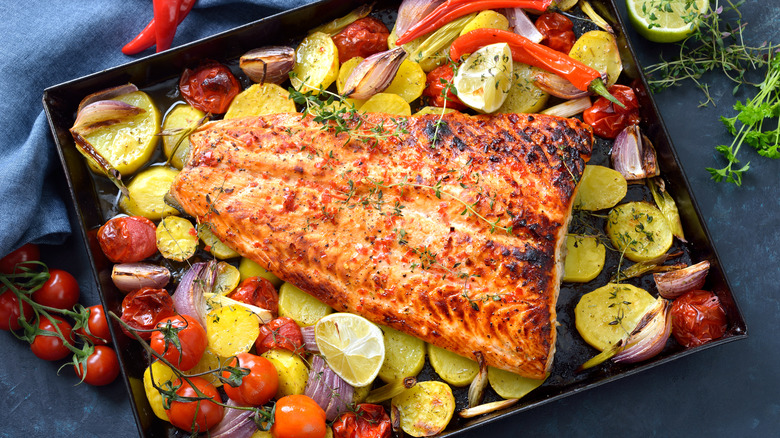
We all love a set-it-and-forget-it option. As we return to the swing of busy school nights and activities, kitchen efficiency is often necessary for weeknight meals. We’re happy to report that baked salmon ticks all the boxes regarding taste and effortless, straightforward appeal. It’s an excellent option for a rushed Wednesday night meal.
There is one trick to making a moist and tender baked salmon that every home cook should know: Keep salmon uncovered when baking for optimal results. Doing this will help keep the fish from overheating, a process that coerces the fish to release the gunky white substance, a coagulated protein, which, while perfectly edible, does take away some of the enjoyment due to its look and texture.
Depending on the size and thickness of the fish and the efficiency of your oven, most salmon fillets will cook best when baked in an oven set to 425 degrees Fahrenheit and left until they reach an internal temperature of around 145 degrees Fahrenheit. This process typically takes approximately 10 minutes but will vary based on the size of each piece of fish.
How to roast salmon

Lauripatterson/Getty Images
Like baking, roasting salmon is a fantastic, fuss-free method of cooking this popular fish. Simple and effective, roasting is an excellent method for quick, hands-off cooking — the perfect solution to having dinner on the table in a flash on a busy work night.
There are two different ways to roast salmon, depending on the amount of time you have. The first is a quick option: Simply preheat the oven to 425 degrees Fahrenheit, lightly grease a baking tray to prevent sticking, and then lay however many fillets of lightly marinated salmon with their skin still on onto the tray, skin-side down. Depending on the thickness of the fillet, the whole cooking process shouldn’t take more than about 15 minutes. That’s enough time to make a salad, blanch some beans, or cook pasta for a quick and easy mid-week meal solution.
For those with more time to linger in the kitchen, slow roasting a side of salmon, as Samin Nosrat suggests in “Salt Fat Acid Heat,” is a show-stopping dinner party dish and well worth the time to achieve the tender, flaky results.
How to cook salmon ‘en papillote’
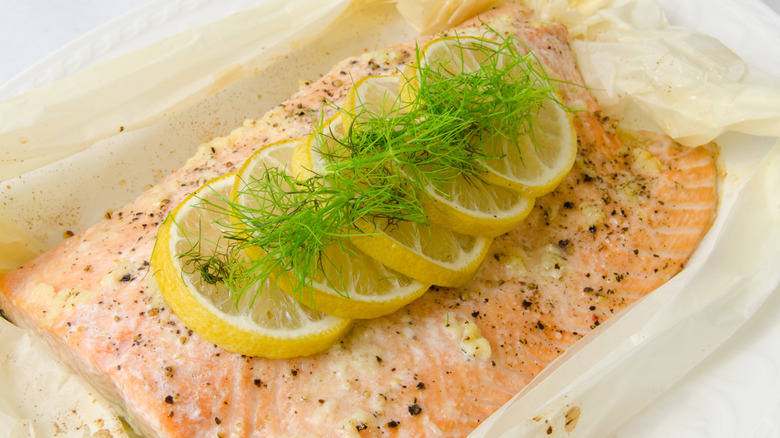
Though it’s fun to say, cooking ‘en papillote’ actually sounds a lot fancier than it is. Easy and accessible, cooking en papillote, whether fish, chicken, or vegetables, is a wonderful method for those who hate to wash dishes, as it uses very little of them. The name, which translates to “in paper,” relies on using parchment paper rather than a pot or pan to create little parcels of perfectly wrapped food. Each packet becomes its own steaming vessel, enclosing moisture-rich, delicate ingredients like fish, tofu, or vegetables.
To make flavorful salmon en papillote, heat the oven to a maximum of 450 degrees Fahrenheit (or you’ll risk catching the paper on fire). Then, to each 12–14 inch piece of parchment paper, add the salmon fillet, any vegetables you might want to use, herbs or spices, and a drizzle of oil or butter. Then, bring the sides of the parchment paper together at the top and fold, ensuring the parcel is sealed, and juices or steam won’t leak or run out the sides. Cook until the parcel has puffed up and darkened. To add some real drama to your next meal, serve each parcel, still sealed, for guests to very carefully unwrap at the table.
How to steam salmon
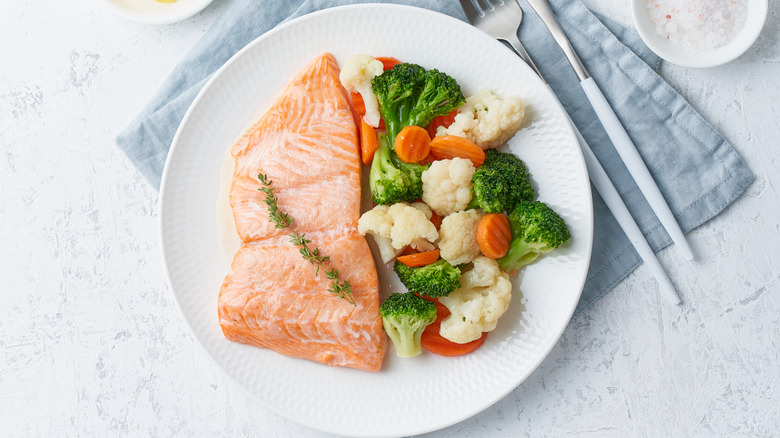
Steaming salmon is likely a less common method for cooking this particular fish in the U.S. Still, it’s one worth trying. Steaming is a healthy, easy cooking method that helps accentuate the best qualities of many foods. It is a method that has spent far too long being shunned for being boring rather than celebrated for its ability to highlight delicate textures and subtle flavors, allowing the ingredients to shine.
There are a few key things to ensuring your steamed salmon is a success. First, flavor the fish with plenty of aromatics like garlic, ginger, lemon, dill, or scallions. This is true with every cooking method, but especially here, as steaming won’t add caramelization, char, or additional flavors; instead, it accentuates what is already there.
Next, if cooking more than one fish fillet at a time, leave space around each piece of fish so the steam moves around to cook. After you set up your steamer and bring the 1 inch or so of water to a boil, reduce to a simmer, and add the steaming basket of well-seasoned fish. Cover with a lid and steam for five to 10 minutes, depending on the thickness of the fish. For a light and flavorful dinner, serve fish with steamed jasmine rice and green vegetables.
How to cook salmon in an air fryer
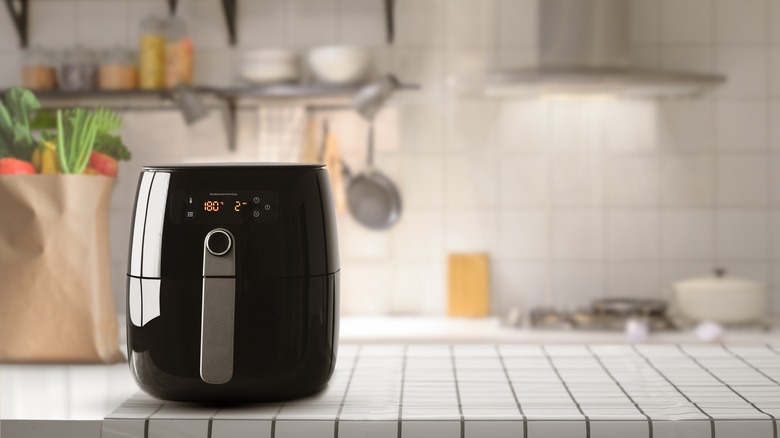
These days, you would be hard-pressed to throw a stone and not hit an air fryer (or someone telling you to use one). We are no exception. With a little counter space in many kitchens, there is little room for prep space-sucking gadgets that don’t pull their weight.
Fish can be tricky for the air fryer, however, as the delicate texture can sometimes lend itself to drying out during the cooking process. For starters, consider choosing farmed salmon over wild, ensuring a fattier piece of fish and reducing the risk of over-drying. Or, if using wild salmon, reduce the cooking time or brine the fish first to compensate for the lower fat levels.
Next, if you haven’t already brined the fish, salt it before cooking in a preheated air fryer (400 degrees Fahrenheit usually), ensuring to dab any excess moisture with a paper towel. These simple but effective steps will help to ensure moist, succulent fish as the result of your efforts. This Korean-style air fryer recipe from Joe Dillard is a must-try for those looking for a sweet and spicy salmon recipe.
How to grill salmon
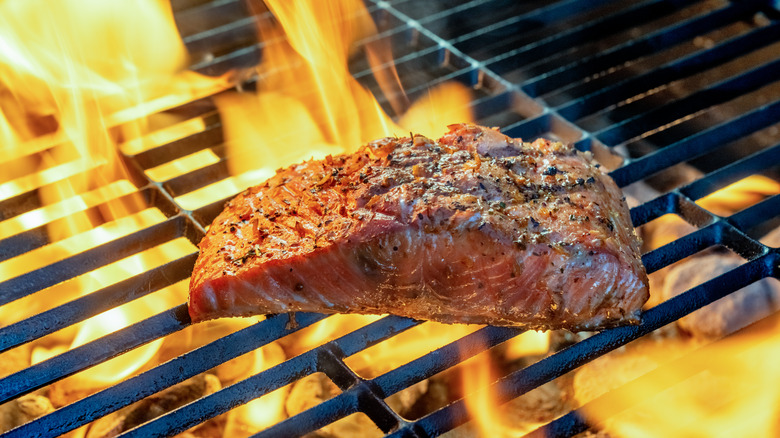
There’s just something irresistible about that smoky, charred flavor from grilling fish — salmon especially. The smoky flavors match perfectly with the meaty fish; the combination is simply irresistible. When it comes to grilling fish, there are several methods to choose from that result in a perfect piece of fish.
Depending on the marinade, seasoning, or spice rub, you can place fish directly on the grill itself, though make sure you have cleaned and prepared the grill in advance to ensure it’s clean, non-stick, and ready to go. You won’t have to worry as much about sticking if you’re using a dry blend of herbs and seasonings, like with our cajun grilled salmon recipe. However, wetter marinades, especially ones that encourage caramelization due to their sugar content, might require a different method of grilling for best results.
Try wrapping salmon in a bit of foil for sweeter sticker glazes and marinades, similar to the en papillote method. This will help keep all those rich juices on the salmon rather than burnt on the grill. The heat inside the enclosed foil case will work to cook your fish in record time. Place the foil packets directly onto the grill and cook for the required time, removing the need to flip the fish or scrape off any bits of burnt food from the grates themselves.
How to pan-sear salmon

For those in a hurry, pan-searing your salmon supper is probably one of the best options, especially for those with little people and little patience left at the end of the day. To match your family’s needs (or your own) without compromising flavor and rewarding your efforts with crispy salmon skin, here’s how to make the most of this brilliant method for cooking salmon.
First, salt your salmon, skin on, just before it hits the pan to ensure it retains as much moisture as possible. Pat the underside of the skin with a kitchen towel to remove excess moisture, then heat your pan. Place your freshly salted and patted salmon fillets into the pan, skin-side-down, and apply gentle pressure for up to 30 seconds. Now, take comfort in knowing the bulk of your work is already done. While we don’t recommend walking away from the pan, you can focus on other pots on the stove or meal prep work while the fish cooks away.
Searing the fish skin-side-down results in a crispy finish. It also helps to reduce the likelihood that albumin, the gunky white stuff, will be released from the fish. The fish will be ready to be flipped in about six to 15 minutes, depending on its thickness. All it will need is a quick kiss of the pan (about 10 seconds) before it is ready to remove and serve.
How to cure salmon at home
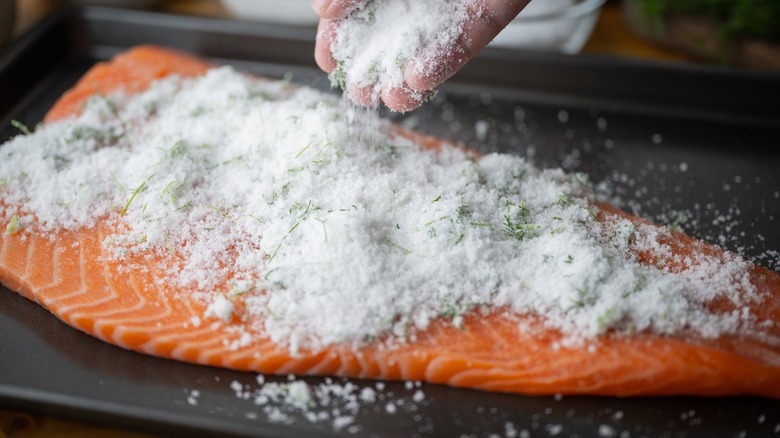
There’s something about home-curing salmon that feels a bit like alchemy. Those who have successfully cured fish at home will know the sense of pride and accomplishment you feel when presenting the dish to friends. Despite feeling a bit fancy, most of the curing’s hard work is done by nature, making it an approachable way to wow friends. Plus, doing it yourself can help to save a bit of money, usually spent on this coveted delicacy.
Curing salmon involves just a couple of key ingredients: salmon and salt. The rest will vary down to the recipe but can include pepper, lemon, herbs, and brown sugar. Just like the short list of ingredients, only a few key steps are needed to create tender cured fish.
First, pat down either a side of salmon or individual fillets with a paper towel to remove any excess moisture. Then rub and cover the flesh of the fish with copious amounts of salt, plus pepper and brown sugar or herbs if using. Reserve a little of this curing mixture for the skin as well. Once fully covered with salt, tightly wrap the fish with plastic wrap and set it on a baking tray. After 12 – 24 hours in the fridge, pressed under a heavy object, the fish should be fully cured and ready to slice and pile onto a blini or bagel. Eat your heart out, store-bought lox!
How to smoke salmon

When it comes to smoking fish, it’s imperative to have the right ingredients and equipment before putting it into the weekly dinner plan. A smoker is sadly out of the question for many of us due to a shortage of time, money, and space. Thankfully, there are a few ways to achieve similar flavors at home without purchasing a smoker.
To replicate the hot smoked salmon at the fish counter, all you need besides the fish is a bit of sea salt and sugar, wood chips like applewood, a baking tray, and an oven. Create a sugar and salt rub to cure the fish lightly, then rinse off, pat dry, and rub with oil. Line the baking tray with foil and then wood chips. Place your fish on a wire rack over the wood, then cover the whole thing with foil, creating a dome-like oven to retain the smoke. Place the tray over medium heat until the wood begins to smoke. Once it does, remove it from heat and leave it to cook and smoke for 20 minutes, infusing the salmon with all the wood’s smoky flavors.
If this process seems too intense, there are a few other ways to achieve a smoky flavor. Open up your spice drawn and reach for the ancho chili powder and the smoked paprika, then sprinkle liberally while cooking.
How to stir-fry salmon

Meatier fish like salmon make a great addition to stir-fry because it holds its shape well, unlike more delicate, flakier fish that tend to fall apart during cooking. There are two ways to stir fry salmon, depending on whether or not you are keeping the fillet whole or breaking it into bite-sized chunks instead. Despite its sturdiness, salmon still doesn’t take well to being tossed around too much. Therefore, it’s best to cook the salmon before or after the vegetables, then throw the mix all together at the end.
You can begin by heating a small bit of oil in a wok, then cooking the salmon skin-side down like you would with pan-searing. Pour over the marinade, flip it over only briefly to sear the flesh, then remove from the pan to stir-fry vegetables. This method will serve the salmon directly onto the plate with the stir-fried vegetables scattered on top or below the fish.
Alternatively, give Jeremy Pang’s method a try. Cut skinless, boneless salmon into bite-sized chunks. Then cook any harder vegetables first, removing them from the wok before cooking the more delicate fish to sear and flash fry. Finish the dish by adding the cooked vegetables back into the wok alongside a generous amount of sauce, melding the flavors together briefly before serving.
How to make poached salmon
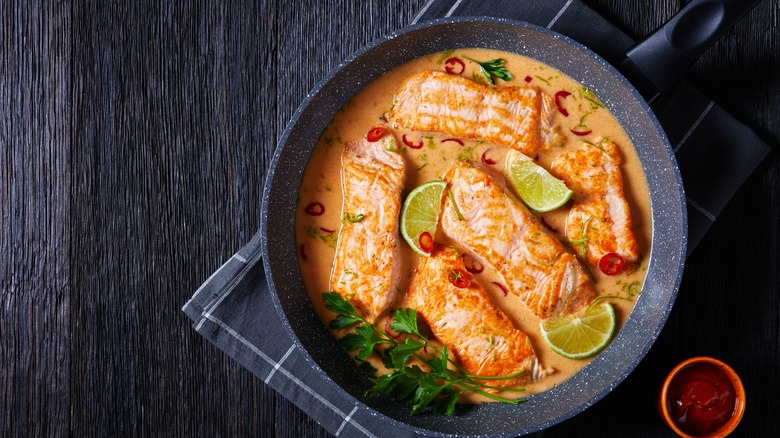
Poaching is a cooking method that, despite its simplicity, is often revered as daunting. We believe the quest to achieve a perfectly poached egg might be at the source of this fear. Thankfully, poaching salmon couldn’t be easier, healthier, or more delicious. With only a few essential tips and tricks, even the clumsiest of home cooks can achieve a perfectly poached piece of salmon in under 20 minutes from start to finish.
First, it is beneficial to see the poaching liquid as a vehicle for flavor rather than just water for cooking. Season the water with aromatics such as lemon, herbs, lemongrass, bay leaves, garlic cloves, and salt to help infuse flavor into the salmon. Or skip the water altogether and instead use stock, coconut milk, or even orange juice to add flavor to every bite.
No matter what liquid you choose, bring it to a boil, then reduce to a simmer and carefully slide in the salmon fillets, completely covering the top with liquid. Continue to gently simmer until the fish is a pale pink. When the poached salmon easily flakes — usually between five and 10 minutes —you know it’s ready.
How to store salmon
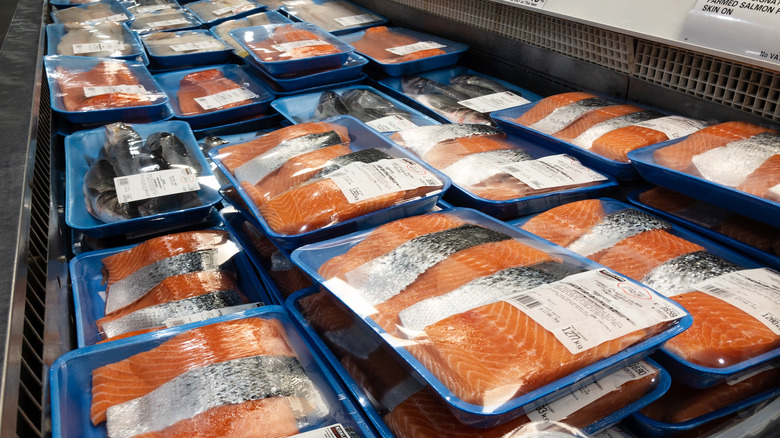
Has this list inspired a craving for salmon? We’re not surprised. For those who’ve added salmon to your grocery list this week, you may wonder how best to choose and store freshly purchased salmon fillets.
Firstly, don’t be afraid to ask if the fish is fresh when heading to the fish counter. The fish shouldn’t smell overly fishy. The same is true once you’ve brought the fish back home and tucked it into the fridge. If it smells overly fishy by the time you go to use it, you may want to reconsider whether it’s still good. Freshly caught salmon will only remain fresh for around two days in the fridge when stored in the meat drawer at a temperature of 32 degrees Fahrenheit.
Fresh fish is somewhat of a use it or lose it situation. So, if you plan on making salmon later in the week, it’s best to move it to the freezer immediately for more fresh-tasting results rather than letting it linger for a few days before doing so.
How to reheat salmon

Mvp64/Getty Images
Leftovers can be a godsend when making quick lunches or heat-and-eat options for busy weeknights. Brain health-boosting oily fish like salmon can also be a tasty and nutritious option for on-the-go meals. Reheating fish, however, can sometimes be like navigating uncharted waters when it comes to knowing how to do so safely that won’t leave the fish dry and flavorless.
If you have access to a conventional oven for reheating purposes, that’s likely the best option for the most satisfying and succulent results. Tuck the salmon, ideally covered with foil to prevent it from drying out, into an oven preheated to 275-300 degrees Fahrenheit for around 15 minutes. It won’t taste quite as good as the first time around, but it shouldn’t be bad, either.
For those who only have access to a microwave, covering the salmon with a bit of parchment paper, a paper towel, or a loosely fit lid is highly recommended. We’d also recommend using a lower setting, like 30%, heating in 30-second increments, flipping the fish, and repeating until warm.







